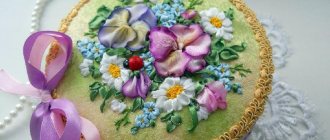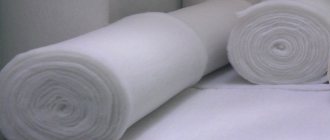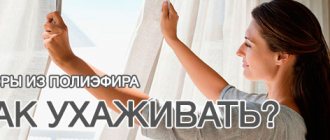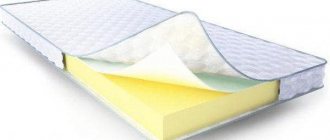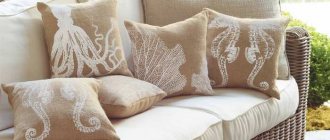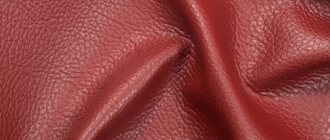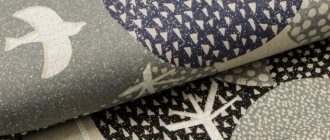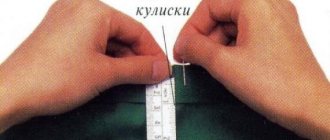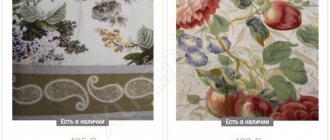What is canvas and what is it for?
Embroidered paintings are created with many identical stitches of different colors, to which other types of stitches or beads can be mixed in small quantities. To ensure that the stitches are even, of the same size and tension, canvas . This is a fabric that has a special weave of threads, which allows you to get holes at an equal distance from each other .
On the entire canvas, they themselves and the distance between them, determined by the number of threads, are the same, thanks to which it is possible to achieve ideal evenness of the entire embroidered product. Using high-quality canvas greatly simplifies the embroidery process and makes it as comfortable as possible. This foundation also allows you to minimize eye strain and greatly reduce the risk of errors. Ready-made embroidery kits are equipped mainly with Aida , the count of which can be from 7 to 22 .
Editorial voice
Matryona
Fan of embroidery and sewing
Ask a Question
uniformly weaved fabrics are used instead .
Like canvas, they allow you to make even stitches, but noticeably smaller, since the distance between the holes in the uniform is only 1 thread.
Fabric composition and its properties
Modern two-layer canvas. The top layer is made of polyester or nylon, the bottom (base) is usually polyester or cotton. Double-layering helps the material be more durable and resistant to thread breaking. Sometimes the material is additionally strengthened with Teflon impregnation: it becomes more moisture and dirt resistant. And caring for such fabric is simplified.
Polyester-based canvas does not wrinkle, holds its shape well, and does not absorb odors. The cotton base allows the fabric to “breathe”, absorbs moisture well, but wrinkles.
This material has the following properties:
- strength;
- high wear resistance;
- tear resistance;
- hypoallergenic;
- breathability;
- color fastness;
- ease of care.
Varieties of canvas
The choice of base for embroidery is very wide. Experienced needlewomen always have favorite types of canvas that they choose for most of their projects. Manufacturers of embroidery bases may be different, but the sizing chart is always the same .
Aida canvas
This is the most popular type of base for embroidery. The highest quality product is produced in Germany. Belarusian canvas is very flabby, which makes it inconvenient to embroider on it. The fabric from the Russian manufacturer Gamma is of consistently high quality, but in terms of starchiness it is slightly inferior to the German one. Any type of Aida canvas is made from 100% cotton. It is woven with 4 by 4 threads, which ensures perfect evenness of the crosses. The count of the fabric changes when the thickness of the threads and the density of their fit to each other changes. The cost of this canvas, depending on its count, varies among different manufacturers - from 500 to 1500 rubles per meter.
- Aida 7 or children's . This is the largest tissue and 10 cm of this tissue contains 27 cells. The weave of the threads is wide, the work can be easily done with a thick thread. Its main purpose is to use it to teach embroidery to children. It is usually used in schools during labor lessons. Patterns on it are created only with a cross and a half-cross.
- Aida 11 . The base is also quite large; 44 cells in 10 cm of this canvas. Used for tablecloths, napkins, decorative runners, covers and pillowcases for sofa cushions. Simple patterns are embroidered on it that do not require delicate color transitions. Such a base is often included in embroidery kits for children, as well as for people with low vision.
- Aida 14 . Contains 55 cells per 10 cm. This base can be called a classic. It is most popular among embroiderers, as it allows you to embroider a complex picture without straining your eyes. Embroidery on such fabric is carried out using 2 or 3 threads of floss using a 24-number needle. Most embroidery kits include just such a base.
- Aida 16 . 62 per 10 cm . The embroidery on it is clearer due to the reduction in the size of the crosses. The boundaries of the details become clearer. Embroidery is carried out in 2 threads of floss with a needle No. 24. The stitches fit tightly to each other, the base does not show through from underneath them. This canvas number is included in sets with complex designs that contain a large number of small details.
- Aida 18 . 72 cells fit in 10 cm It is used for large complex designs that require special clarity of all image details. The size of the embroidery in comparison with Aida 14 will be significantly smaller, which also attracts needlewomen to this base. Embroidery is carried out in 1 or 2 threads with a 26 or 28 number needle. Often, glasses or a magnifying glass are required to work with such a base, even in the absence of vision problems.
- Aida 20 . 79 squares fit in 10 cm This is a very fine Aida, which is used for maximum detail when creating multi-color large paintings and miniatures. When working with such a base, it is recommended to use a magnifying glass to avoid eye strain.
Aida 7 ct
Aida 11 ct
Aida 14 ct
Aida 16 ct
Aida 18 ct
Aida 20 ct
When buying canvas for embroidery, you need to take into account that to design the finished work you need to have a supply of fabric. It is necessary that there is a fabric allowance of 6-10 cm . All this can be calculated in detail and visually assessed in our canvas calculator. If it is smaller, difficulties will arise when designing the work and when stretching the embroidery onto a hoop or frame. Starched types of Aida are not prone to fraying at the edges, so there is no need to overcast it. In embroidery kits, the canvas often comes with a finished edge.
Uniform or uniform weave fabric
This base is much smaller than the canvas . She doesn’t have such pronounced holes as Aida, and if you don’t look closely, you get the impression that it’s a smooth canvas. Embroidery on such a basis requires significant skills from the needlewoman. In order for the stitches to be even and smooth, you will need the ability not to overtighten the thread. The uniform work looks very beautiful and elegant. This small base should be chosen for embroidery in which a large amount of fabric remains unstitched, as well as for multi-color volumetric patterns, if you want to minimize the size of the finished work. The cost of such fabric ranges from 1300 to 2500 per meter.
- Bellana . This fabric contains 52% cotton and 48% rayon. The threads do not cross tightly; when embroidering, the needlewoman must control the stitch tension herself. This fabric has 20 threads per inch. You can embroider on this basis with a half-cross stitch and a tapestry stitch through 1 thread and a cross stitch through 2 threads. The base is used to create napkins, tablecloths and paintings.
- Lugana 25 . Its composition is similar to the previous fabric; there are 25 threads per inch. Its manufacturer is the German company Zweigart. This uniform pattern is distinguished by its elegance and is used when embroidering pillows, tablecloths and other decorative items that require a particularly attractive type of base. Most often it is embroidered with a cross.
- Linda 27 . This is a 100% cotton fabric with 27 threads per inch. It is suitable for the basis of embroidery or sewing clothes that are planned to be decorated with an embroidered pattern. It is also used to make tablecloths, napkins and curtains. Craftswomen often use this fabric to reduce the size of large embroideries. In this case, work is carried out through 1 thread. If you embroider using 2 threads, the size of the cross will be similar to that obtained when embroidering on Aida 14.
- Hardanger 22 . This uniform pattern is sometimes also called canvas, since the spaces between the weaves of the thread are quite clearly visible. Embroidery on such material is done with a cross, half-cross or tapestry stitch. It is also convenient to use this base for counted satin stitch and backstitch. It is easy to recognize it among other uniforms by its clear holes.
Bellana
Lugana 25
Linda 27
Hardanger 22
Embroidery kits are rarely equipped with evenly woven fabrics. The exception is kits for creating samplers and embroideries using primitive techniques. You can make an exact calculation for the product using the uniformity calculator.
Linen fabrics
Linen fabric is particularly durable . Unbleached flax has a pleasant grayish color. The following bases are used for embroidery using the hardanger, cross and hemstitch techniques. The work is usually carried out through 2 warp threads. Depending on the count of fabric, 1 inch can have from 18 to 40 threads.
- Dublin . One of the most popular linen fabrics, 10 cm of which contains 100 threads. It is most convenient for beginner needlewomen who have decided to try embroidery on linen for the first time. The work is carried out in 2 or 3 threads of floss through 2 warp threads. Used to make tablecloths, curtains and clothing.
- Edinburgh . There are 140 threads per 10 cm in this fabric. If the embroidery is carried out through 2 threads, the size of the crosses will be comparable to that obtained on Aida 18. Embroidery on such a basis always looks very elegant. The fabric is most often used for blouses, which have collars and cuffs decorated with embroidery.
- Newcastle . Contains 160 threads per 10 cm. This is the newest linen fabric produced. It is intended mainly for creating particularly elegant embroideries.
Dublin
Edinburgh Newcastle
Linen fabrics of uniform weave are used extremely rarely for embroidery of paintings. They are expensive and often difficult to find on sale.
Have you tried linen fabrics in your work?
Not really
Stramin
This is a very rigid base on which products in the carpet technique, as well as tapestries, are made. Its fibers are distinguished by their strength and rigidity. Stramin has a special type of weaving and processing, which allows you to work with it without a hoop. The squares of this base are very clear. If desired, if you purchase a stramin of count 14, 16 or 18, you can do cross stitch on it. The price of such fabric for 1 meter starts from 600 rubles.
Plastic canvas
A distinctive feature of this canvas is that it is made not of thread, but of plastic . It easily holds a given shape and is used to create unusual three-dimensional embroidered figures. The sizes and colors of this canvas are varied. It is sold not by the meter, but by sheets. If you purchase kits for making figures on plastic canvas, it will already have the required shape. You should embroider on this basis without using a hoop. If the reverse side of the craft is visible, you will need to achieve its perfect execution, which is quite labor-intensive.
Overlay canvas
This canvas is also called deleted . It is used when it is necessary to do embroidery on fabric that does not have a uniform weave. Typically, an overlay canvas is required if you need to decorate a T-shirt, bag or dress with embroidery. The threads of this canvas are thicker than those in Hades, and there are more holes. Sometimes manufacturers mark it with blue thread every 10 squares. If it is not there, you will have to line it yourself. In such a warp there can be 8, 10, 14 or 18 threads per 1 inch. When the embroidery is finished, the threads of the overlay canvas are pulled out. The cost of such fabric starts from 600 rubles per meter.
Water Soluble Canvas
This base, like the invoice, is used when it is necessary to embroider on fabric that does not have a uniform weave. It is made from a thin plastic sheet with perforations. When the embroidery is ready, to remove the base it is enough to immerse it in water at a temperature of 50 degrees for 10-15 minutes. During this time the plastic will completely dissolve without making the fabric of the item dense or hard, on which the embroidery will remain. When working with it, you must take into account that only threads that can withstand washing in warm water can be used. This canvas is produced in pieces measuring 20 by 22 cm. The cost of one is about 300 rubles.
Perforated paper
Today such a basis is rare. Usually it corresponds to Aida 14. Embroidery is carried out in 1-2 threads. When working, you must be especially careful, as otherwise the paper may tear. The material is used primarily for making postcards and bookmarks .
What is canvas count
Canvas count is the number of cells that fit in 1 inch (2.54 cm) . The more squares you place, the smaller the crosses will be. The number in the name of the outline indicates the count (ct). In the tables, manufacturers indicate the entire size range of the canvas they produce. They allow you to accurately determine the characteristics of a particular company’s products.
How to calculate canvas size
To work, you need to correctly calculate the size of the canvas. The kits already contain the required cut. If you need to calculate it yourself, you can use a special canvas calculator online. You can also count the number of holes in 1 cm of fabric and then divide by this number the number of crosses in the diagram, by height and length separately. You should also leave 6-10 cm for allowances along the edges.
The right embroidery canvas will allow you to get the optimal result for each design. Many manufacturers of complex cross stitches sell them without threads and warp; in this case, it is very important for the needlewoman to be able to choose the right canvas.
Selecting fabric for embroidery based on manufacturer
The market offers a fairly large assortment of canvas manufacturers. The most popular today are Belarus, Hungary and Germany. In terms of properties, the first is very soft, but after a discount it is prone to deformation, the second is hard, which is not very convenient to use and does not look beautiful, the third is the option that you should give preference to without hesitation. The world's most popular German manufacturer is Zweigart. A huge variety of fabrics, amazing quality, wear resistance.
You might be interested in How to work correctly with contours Decals for fabrics
Zweigart.
Embroidery is a very complex and painstaking work, so in order not to devalue your work, it is recommended to initially take good materials.

